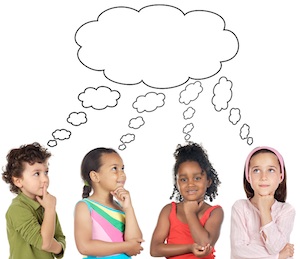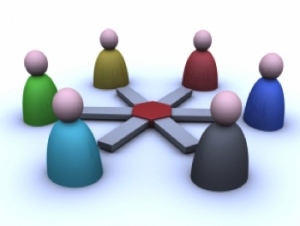 How CAN we help our students be the kind of thinkers we want?
How CAN we help our students be the kind of thinkers we want?
Several years ago, my friend and colleague, @brendasherry, wrote a thoughtful post called What is Deep Understanding? She asked several excellent questions:
- what kind of thinkers do we want our students to be?
- what is deep understanding?
- can schools really provide the learning environment to nurture and develop it?
In thinking about these questions, I would like to also ask: “How can we help novice learners become more expert learners?”
Novice Learners versus Expert Learners
First, let’s look at the difference between a novice and expert learner.
- Novices typically don’t plan, monitor, and reflect on their learning
- These metacognitive skills include setting goals and subgoals; identifying approaches; monitoring one’s progress to the task; revising goals where necessary; and, reflection after task completion.
- Expert learners use ‘multiple representations’
- to build a fuller, more complete understanding. And, of course multimedia allows for this – text, graphics, sound, dynamic models.
 Novices typically don’t generate a number of potential solution strategies
Novices typically don’t generate a number of potential solution strategies
- Novices, when presented with a task, typically jump at the first idea that comes to mind. Expert learners, on the other hand, tend to generate and evaluate a number of potential approaches to the problem.
- Novices engage in ‘knowledge telling’ rather than ‘knowledge transformation’
- One 5th grade girl, Larissa, was planning to do her project on potato production in Prince Edward Island. She was reminded, in a collaborative journal-writing environment, that the class had studied acid rain for the last month. Larissa was challenged to make sense of that and to determine if acid rain had had any impact on potato production. This improvement in her strategy was more representative of ‘expert’ behaviour.
- Expert learners make multiple passes at knowledge
- Many sources should be ‘read’ and consulted – books, videos, Internet, PLN (Personal Learning Network – Facebook, Twitter).
- Experts view ‘mistakes’ as opportunities to learn
- ‘Debugging’ strategies are invoked when things go wrong. Therefore, you backtrack through your thinking – you exercise metacognition or ‘think about your thinking’. Experts recognize the value of this. Novices typically don’t.
- Experts are able to transfer their learning to other domains
- Novices don’t naturally transfer their understandings to other tasks or to other subject domains.
- Experts realize that the ‘social context’ is important to learning
- That learning takes place in a social context is a significant issue. This is why collaboration or ‘cooperative learning’ has become so popular – but it has to be more than social collaboration. Cognitive collaboration needs to be encouraged. As students communicate their ideas, they learn to clarify, refine, and consolidate their thinking. Schoenfeld has said that, ‘Groups are not just a convenient way to accumulate the individual knowledge of their members. They give rise synergistically to insights and solutions that would not come about without them.’
Scaffolded Journal Writing
So, how can we help students become more expert? In an effort to implement all this in the classroom, I have used collaborative journal writing environments over the years. I used to do it with HyperCard back in the day, then with FileMaker Pro, then LCSI created Journal Zone with me, and recently I have been using blogs, wikis and Diigo.
 I have found that (in addition to the familiar strategies associated with student-driven, authentic inquiry-based projects) scaffolded, collaborative journal writing is helpful to move kids beyond the social comments. Below I share some of the sentence starters I have used.
I have found that (in addition to the familiar strategies associated with student-driven, authentic inquiry-based projects) scaffolded, collaborative journal writing is helpful to move kids beyond the social comments. Below I share some of the sentence starters I have used.
Some explanation: The planning starters might be used at the beginning of the work session; the reflection starters at the end. The comment or discussion starters can be used to help kids give more substantive feedback to peers.
The elaboration triggers are connecting words or phrases that can be used to help kids extend their thinking beyond what they might otherwise attempt. So once they write something, they are encouraged to check the list of ‘elaboration triggers’ to think more deeply.
These starters are obviously designed to address the issue of moving the learner along the continuum from novice to expert.
Planning Starters
I want to know…
I want to learn…
I think…
My goals for this project are…
I don’t understand…
I wonder…
I am having difficulty with…
I am breaking my project into…
A similar task I have had before is…
The steps I plan to follow are…
Different ways to solve this task…
Reflection Starters
I learned…
Things I want to learn are…
I think…
I have managed to…
I have changed my plan…
I didn’t get as far as I planned because…
I got further than I had planned because…
The steps I did first were…
My next step will be…
Comment or Discussion Starters
I agree with you because …
I disagree with you because…
Check…
I think…
I believe…
Have you thought about…
Maybe…
I am confused…
Another explanation…
I don’t understand…
You need to…
Your journal entry would be better if…
Elaboration Triggers
study
thanks to
that’s how
that’s why
therefore
think
try
until
wish
wonder
in that case
in view of
look forward to
otherwise
plan
realize
remember
since
so
expect
explain
feel
figured
give up
Guess
hope
if…then
intend
another
as a result of
attempt
because
believe
consequently
consider
decide
discovered
discuss
Some challenges
Several challenges exist. One, this can become simply another classroom exercise — worksheet-like. NOT the intent.
 Try to engage your students in developing their own sentence starters. Engage in the discussion by adding comments of your own that are substantive. Model what you want the kids to do. Encourage the philosophy in the classroom that “deep thinking is a highly valued activity.”
Try to engage your students in developing their own sentence starters. Engage in the discussion by adding comments of your own that are substantive. Model what you want the kids to do. Encourage the philosophy in the classroom that “deep thinking is a highly valued activity.”
The collaboration tools (wikis, blogs, Diigo) are not designed to ease the use of these starters. I have kids copy and paste the ones they want to use into their post or into their reply. Or, with Diigo, they can simply copy and paste them from any text file available. But, availability is the issue.
Finally, ideally you want the kids generalizing this behaviour and appropriating the use of deep discourse. In order for that to be the case, it must serve the kids well. This may require your effort in making the connection.
Questions? Confusion? Suggestions? Insights? Leave a comment and we can start some dialogue!
Peter Skillen
Latest posts by Peter Skillen (see all)
- Project Based Learning (PBL): Am I Doing it Right? - February 14, 2019
- The Science of Passion Based Learning - April 9, 2013
- Scaffolding for Deep Understanding - November 30, 2012


Love the “elaboration triggers” – that’s a fun way to think about it. My Grade 7’s and 8’s in their homeroom classes are starting to work on their annual HUGE projects on multicultural festivals at this time of year, and some of them really need this kind of scaffolding to go a little deeper. Much appreciated.
Hi Lisa!
Thx for the feedback.
One of the other things I have really found useful is to organize face to face discussions based on such prompts as:
Hey, go back through the journals of your group and find out where someone has:
– used an old idea in a new way
– identified, and then solved, a problem
– had an ‘aha’ moment
Keep me posted on how it goes!
Good stuff. I could use this material in class. Thanks for taking the time to write this.
Dr. Gerdes
Hey Darin,
Thanks!
I’d love to hear how it works for you in class. What works? What doesn’t work? What you changed… and so on!
Sound like a plan? 🙂
Peter
Nicely done. Cross posted to Phi Beta Iota the Public Intelligence Blog.
Awesome!
Hope your readership finds it useful and that they build on these ideas and improve them!
thx
peter